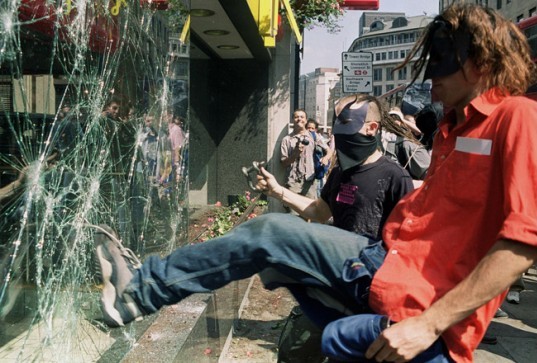 The London riots have taken the country by storm. Yesterday we reported that BlackBerry Messenger had become the communicator du jour of the protesters, who were taking advantage of the private texting application and its encryption features to stay a step ahead of authorities.
The London riots have taken the country by storm. Yesterday we reported that BlackBerry Messenger had become the communicator du jour of the protesters, who were taking advantage of the private texting application and its encryption features to stay a step ahead of authorities.
This isn’t the first mass demonstration whose participants have utilized technology to aid their cause. Movements in Egypt, Libya, and Syria were among those that took to YouTube, Twitter, Facebook, and cell phones to organize and communicate. But those public outlets are easy to trace, and BBM is believed to be a crucial tool of the London rioters.
It’s also spoken to RIM’s surprising influence. The handset manufacturer has been associated with weak sales and ill-fated gadgets lately, and the BlackBerry has become almost archaic in the younger generation’s eyes. But the smartphone of the enterprise community clearly has a place in London, given its widespread and considerably effective use in the riots. This user allegiance will likely be challenged, however, seeing as RIM is cooperating with Scotland Yard to turn over protestors using the service to coordinate. London attorney Mike Conradi told The Guardian today that, “It would be unlawful of RIM to disclose the contents of messages without a warrant issued by a senior police figure or a secretary of state – but that doesn’t mean [RIM] couldn’t disclose information that would be helpful to the police.”
RIM isn’t the only one willing to help authorities. Google Groups has its own mechanism for identifying guilty parties. A Group called “London riots facial recognition” has been started, and members want to use face recognition technology to find and condemn rioters. Using what are public and legal images, members insist their actions fall within their rights. The group’s description explains: “The police are giving us access to CCTV images of the rioters and looters. Let’s use existing technology like facial recognition and social networks proactively to help the justice process happen a little quicker.” Sites like Flickr, Tumblr, and Twitter are also being used to identify rioters.

This use of face recognition technology is precisely what outraged Facebook users when the application was introduced to photo tagging. Some of the backlash was attributed to the idea that if Facebook knew what you looked like, coupled with the information it already had about it, this could be used against you by law enforcement. Face recognition technology in general has inspired fears that we are edging closer to a search-by-image system, where you could photography a stranger, enter the image into a database, and be returned with information like a name, location, occupation… the possibilities are endless given the scope of social networks. The group is even talking about using the Facebook and Twitter open graphs for their identification tactics.
But there’s also the argument that technology, in this particular instance, is just making it easier to hold guilty parties responsible for their actions. If face recognition can lead officials to looters who are ransacking local stores or assailants who are armed, maybe that’s just a technological evolution doing its job. The problem is that it’s not that easy. We know that face recognition has its hiccups, and innocent bystanders or even people with similar facial features could find Scotland Yard knocking on their doors. It’s putting a considerable amount of power into the hands of those who are not law enforcement, and while their intentions might be good, the end result would likely be mixed at best.

